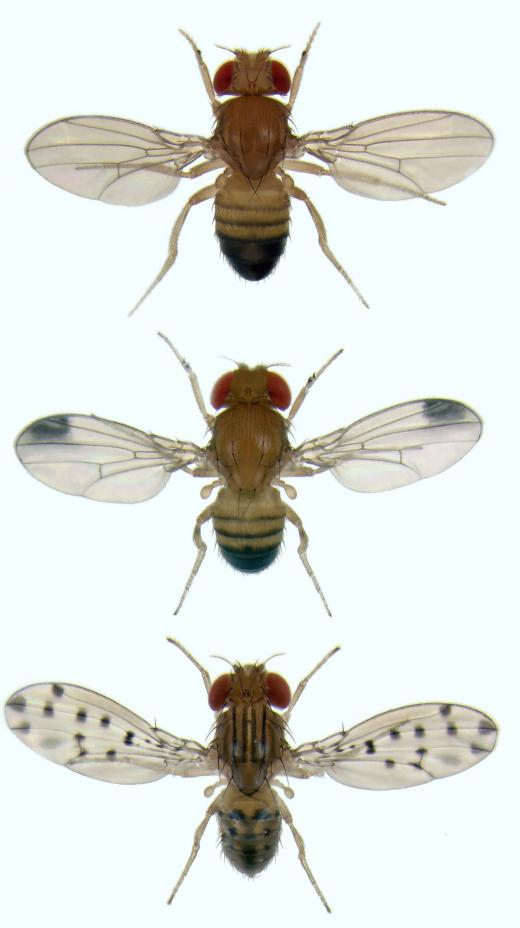What is a Regulatory Gene?
 Mary McMahon
Mary McMahon
A regulatory gene is a gene which determines whether or not genes will be expressed. Also known as regulator genes, some regulatory genes are concerned with a specific gene, while others can handle a group of related genes. These genes are produced by all organisms, and are an important part of the system of checks and balances used to moderate genetic expression so that an organism operates effectively and efficiently.
In some cases, a regulatory gene acts as an activator, turning a gene or group of genes on so that expression can occur. The regulatory gene may respond to environmental pressures, as when an activator in a bacterium activates a gene for antibiotic resistance when the organism is around antibiotics. In complex multicellular organisms, regulatory genes are involved in the process of cell differentiation, determining what a cell will develop into. This allows organisms to have great diversity in cell types, making everything from neurons to skin cells.

Other genes act as repressors, turning genes off so that they cannot express. Like activators, suppressors can go into action in response to a number of different things, including environmental pressures and the needs of embryonic development. These genes can do things like preventing RNA transcription so that genetic material cannot be used. This type of regulatory gene may also act to suppress a harmful gene, keeping an organism healthy.
Like other genes, regulatory genes contain information which is used to code proteins. They are transcribed into RNA, which is used by the cells to build the proteins these genes are designed to express. Once created, the protein can act in a variety of ways on the genetic material inside the cell, depending on what it is intended to do. For example, a regulatory gene might make a protein which locks onto a section of DNA so that it cannot be transcribed.
Identification of regulatory genes is done by studying the genome, finding specific genes, looking at the proteins which they code for, and studying the effect of these proteins. Researchers working with organisms such as fruit flies can do things like turning genes off or on and then observing the results to learn more about what these genes do. In organisms like humans, where genetic manipulation is not considered ethical, researchers can compare genetic information between many humans to look for commonalities and differences, using this information to narrow down the function of specific genes.
AS FEATURED ON:
AS FEATURED ON:











Discussion Comments
@epiphany5 - Thank you for bringing up the topic of gene regulatory networks. You helped to put in perspective how our genes work together to operate our bodily functions.
Sometimes, however, these gene regulatory networks can work against our bodies. I just read a report that says that certain networks contribute to the growth of cancer cells in our bodies. These networks have been identified by researches.
Cancer is an abnormal growth of cells. Once these cells have mutated into cancer cells, their genetic makeup has been altered. All cells naturally grow, so gene regulatory networks of cancerous cells work the same way as they would in healthy cells. Hopefully, through more research, we kind find a medication that will halt the growth of these mutated cells, if not change them back into healthy ones.
Outstanding article! I am a high school anatomy teacher, and I think this article is written in a way that all students could understand. I will forward the link to this article to my current students.
One thing that is important to note is that genes often times do not behave independently from one another. Instead, they work with each other to build the proteins that our bodies need to survive. A collection of genes that work together is called a gene regulatory network. These networks are collections of DNA segments that work with each other through their RNA expressions and other substances in the cell.
To describe what these networks do in the most basic terms, they react to triggers in their environment to mandate how our bodies react. For example, when we eat food, gene regulatory networks respond to this by telling our bodies to produce the proteins it needs to digest that food.
I hope this information is helpful to someone!
@Farah1 - You bring up an interesting topic of discussion. Regulatory genes do play a vital part in the basic make up of our bodies. It is fair to say that if something goes wrong in them, then it can have a major impact on our bodies.
I am by no means an expert in genetics, but I do read my fair share of news stories related to health and fitness. I remember reading an article about some genetic researches that discovered that obesity was linked to a master regulatory gene. Based on the characteristic of this gene, one's body can be more susceptible to health conditions like diabetes or high cholesterol, which are linked to obesity. This regulatory master gene causes certain proteins to behave differently than they would in a normal situation. These differences make a person more likely to have high cholesterol or diabetes.
Since a person gets there genetic makeup from their parents, this regulatory gene can become passed down through generations. This is why a person is more likely to be obese if their parents or other close relatives are obese.
I hope this helps to answer your question.
This is a great article. I am a biology student at a community college, and I will be using this as a reference to study for my next exam. Thanks for writing it.
Reading this article makes me wonder. Do mutations and other malfunctions in regulatory genes cause certain diseases?
Since regulatory genes play such an important role in bodily functions, it seems like they would.
Post your comments